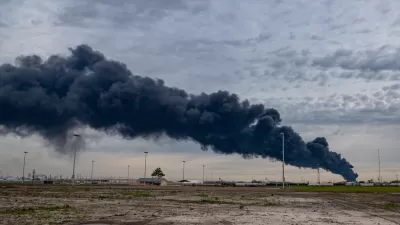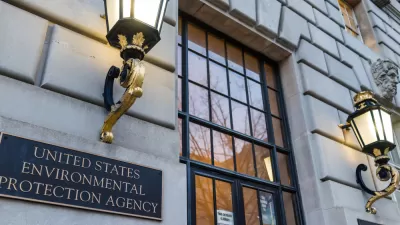Many environmental groups argue the EPA's proposed plan, which is less stringent than California's regulations, doesn't go far enough to support electrification and reduce GHG emissions.

Alex Wigglesworth, Anumita Kaur, Thomas Curwen report on a proposed rule from the Environmental Protection Agency (EPA) that aims to reduce emissions. "The draft rule proposed by the Environmental Protection Agency, which would take effect in model year 2027, would reduce emissions of g nitrogen oxides from gasoline and diesel engines by as much as 60% in 2045, the agency said."
"The proposed rule change was modeled after smog-curbing regulations already adopted by the state of California, although the federal requirements would be less stringent. Many air quality advocates said the rule doesn’t go far enough," according to the article. Environmentalists argue the EPA should more aggressively pursue electrification of heavy-duty trucks, which emit harmful pollution along freight corridors, many of them adjacent to low-income communities. "Although heavy-duty diesel trucks make up just a tiny fraction of vehicles on the road, they produce more than half the on-road pollution in California, said Will Barrett, national senior director for clean air advocacy for the American Lung Assn."
For its part, "California in 2020 passed a rule limiting truck emissions to no more than 0.05 gram of nitrogen oxide pollution per brake-horsepower hour by 2024 and to 0.02 gram by 2027," a goal more ambitious than the EPA's proposal.
The article details other steps California has taken to reduce emissions and improve air quality, as well as the pushback from some in the trucking industry. The EPA will choose one of several options to finalize the plan by the end of this year as "the first step in a series of regulations the EPA will develop over the next three years to reduce pollution from trucks and buses."
FULL STORY: Biden’s EPA proposes new rule to reduce smog from trucks and other heavy vehicles

Study: Maui’s Plan to Convert Vacation Rentals to Long-Term Housing Could Cause Nearly $1 Billion Economic Loss
The plan would reduce visitor accommodation by 25,% resulting in 1,900 jobs lost.

North Texas Transit Leaders Tout Benefits of TOD for Growing Region
At a summit focused on transit-oriented development, policymakers discussed how North Texas’ expanded light rail system can serve as a tool for economic growth.

Alabama: Trump Terminates Settlements for Black Communities Harmed By Raw Sewage
Trump deemed the landmark civil rights agreement “illegal DEI and environmental justice policy.”

How Community Science Connects People, Parks, and Biodiversity
Community science engages people of all backgrounds in documenting local biodiversity, strengthening connections to nature, and contributing to global efforts like the City Nature Challenge to build a more inclusive and resilient future.

Alabama: Trump Terminates Settlements for Black Communities Harmed By Raw Sewage
Trump deemed the landmark civil rights agreement “illegal DEI and environmental justice policy.”

Dear Tesla Driver: “It’s not You, It’s Him.”
Amidst a booming bumper sticker industry, one writer offers solace to those asking, “Does this car make me look fascist?”
Urban Design for Planners 1: Software Tools
This six-course series explores essential urban design concepts using open source software and equips planners with the tools they need to participate fully in the urban design process.
Planning for Universal Design
Learn the tools for implementing Universal Design in planning regulations.
City of Santa Clarita
Ascent Environmental
Institute for Housing and Urban Development Studies (IHS)
City of Grandview
Harvard GSD Executive Education
Toledo-Lucas County Plan Commissions
Salt Lake City
NYU Wagner Graduate School of Public Service





























